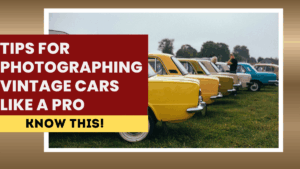Vintage cars are works of art on wheels, admired for their craftsmanship, design, and heritage. Capturing their beauty through photography requires more than just pointing a camera and clicking. Whether you’re shooting for a car show, a sales listing, or your personal collection, applying the right tips for photographing vintage cars ensures the results do justice to the vehicle’s timeless appeal. From lighting and angles to details and backgrounds, every choice matters in highlighting the charm of a classic automobile.

Understand the Car’s Story
Every vintage car has a story, and great photography should reflect it. Before beginning the shoot, research the model’s history. Was it a luxury grand tourer, a rugged off-roader, or a racing legend? Knowing its identity helps guide your style of photography. For instance, a Ferrari 250 GT might demand an elegant backdrop, while a Land Rover Series II looks best in rugged surroundings.
Choose the Right Location
The setting can elevate or ruin your photos. Avoid cluttered or distracting backgrounds. Instead, select environments that complement the car’s design and era:
-
Urban Streets: Perfect for muscle cars and retro sedans.
-
Countryside Roads: Ideal for convertibles and classic tourers.
-
Historic Buildings: Match well with elegant European classics.
-
Neutral Spaces: Parking lots or empty fields let the car stand out without distractions.
Always ensure the background highlights, rather than competes with, the car.
Master Natural Lighting
Lighting is one of the most important car photography tips. Vintage cars, with their chrome trims and glossy paint, reflect light differently than modern cars. Shooting during the “golden hours”—just after sunrise or before sunset—provides warm tones and soft shadows that enhance the car’s curves. Avoid harsh midday light, which creates strong reflections and hides details. Cloudy days are also excellent, as diffused light produces balanced shots without glare.
Focus on Key Angles
Cars have lines and shapes that define their character. Experiment with multiple angles to showcase these features:
-
Three-Quarter View: A classic angle capturing the front and side, showing depth and design.
-
Low Angles: Add drama and emphasize the car’s stance.
-
Side Profiles: Highlight proportions and body lines.
-
Interior Shots: Focus on dashboards, steering wheels, and gauges that define the car’s vintage charm.
-
Detail Close-Ups: Capture badges, hood ornaments, or chrome trims that collectors value.
By varying perspectives, you create a full visual story of the car.
Capture Reflections and Shine Carefully
Vintage cars often feature polished chrome and glossy paint. While beautiful in person, these can create distracting reflections in photos. Position yourself carefully to avoid capturing unwanted objects like yourself, tripods, or random background clutter. Using a polarizing filter can reduce glare and make colors appear richer. Wiping the car clean before the shoot ensures dust and fingerprints don’t show up in high-resolution shots.
Highlight the Interior
The interior is as important as the exterior, especially for collectors. Focus on unique details like wooden steering wheels, vintage radio dials, leather upholstery, or manual gearsticks. Use wide shots to capture the cabin layout and close-ups for finer details. Ensure natural light floods the interior to avoid harsh flash effects, which can flatten textures.
Tell a Story Through Composition
A good vintage car photograph does more than display the vehicle—it tells a story. Include contextual elements, such as period-correct props, classic signage, or even attire that matches the car’s era. For example, photographing a 1960s Mustang with a retro diner in the background enhances authenticity. Balanced composition following the rule of thirds ensures the car remains the star of the frame.
Edit with Subtlety
Post-processing can elevate your shots, but subtlety is key. Adjust brightness, contrast, and saturation to enhance colors without overdoing it. Sharpen chrome details and highlight shadows for depth, but avoid heavy filters that make the car look artificial. The goal is to present the car as true to life as possible, maintaining its vintage essence.
Tips for Car Shows and Events
Photographing at shows presents challenges like crowds, tight spaces, and limited control over backgrounds. To succeed:
-
Arrive early or stay late when fewer people are around.
-
Use a shallow depth of field to blur distracting backgrounds.
-
Focus on unique details that stand out in close-ups.
-
Respect owners and avoid touching cars without permission.
Patience often rewards you with cleaner, more artistic shots.
Selling a Vintage Car? Photography Matters More
When selling a classic vehicle, photos can make or break a deal. Buyers rely heavily on images to assess condition. Provide multiple angles, interior and engine shots, and close-ups of badges or VIN plates. Honest photography builds trust, while professional presentation can increase the car’s perceived value.
Final Thoughts
Mastering the tips for photographing vintage cars is about blending technical skill with artistic storytelling. From choosing the right lighting and angles to highlighting interiors and details, every element adds to the final image. Whether capturing memories, showcasing at exhibitions, or preparing a sales listing, great photography elevates the legacy of these timeless machines. A well-captured photograph not only preserves history but also allows others to appreciate the artistry of classic vehicles for generations to come.
FAQs
What is the best time of day to photograph vintage cars?
Early morning and late afternoon provide soft golden light that highlights curves without harsh reflections.
Do I need special equipment to photograph classic cars?
A DSLR or mirrorless camera with a wide-angle and telephoto lens works best, though even modern smartphones can produce great results with good technique.
How can I avoid reflections in chrome parts?
Use a polarizing filter, adjust angles carefully, and ensure the car is positioned in controlled lighting.
Should I edit vintage car photos heavily?
No, subtle adjustments are best. Over-editing removes authenticity and can make the car look artificial.
Click here to know more.
